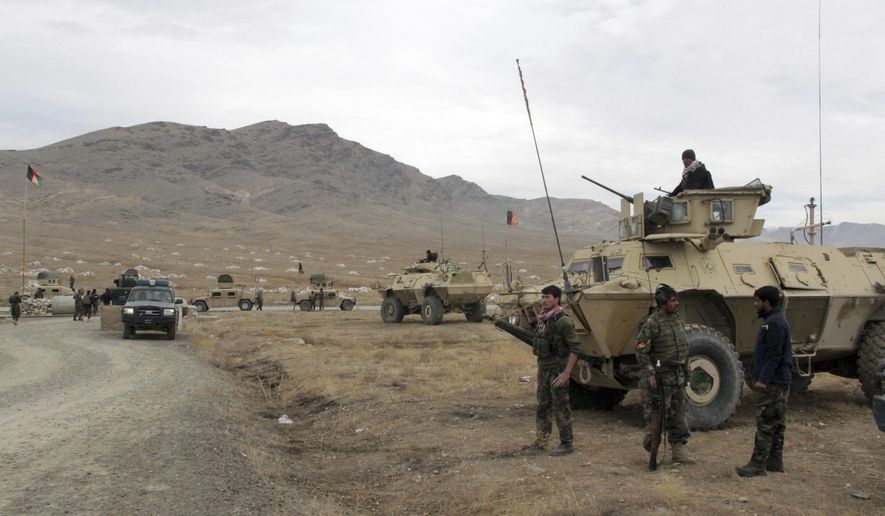NATO leaders say they are facing “hard decisions” about the alliance’s future in Afghanistan.
In many ways, the U.S. has already made choices for them.
Analysts say the Trump administration’s plan to dramatically cut U.S. troop presence in Afghanistan in recent days has forced NATO into a corner and all but guaranteed that the alliance will follow Washington in a march — measured or not — toward the exits. Although presumptive President-elect Joseph R. Biden may tweak the Trump strategy, he has signaled there will be no surge of American troops to the Middle East on his watch, meaning NATO should not expect a dramatic reversal in policy after Inauguration Day.
NATO officials concede that they face a serious dilemma and the daunting prospect of protecting and building up the shaky government in Kabul with historically low American military involvement. NATO Secretary-General Jens Stoltenberg said Tuesday that a moment of truth awaits when alliance defense ministers meet in February to debate a long-term path forward.
“As we continue to assess the situation in Afghanistan, it is clear that we will face a turning point early next year,” Mr. Stoltenberg said Tuesday during a virtual meeting of NATO foreign ministers, including Secretary of State Mike Pompeo. “If we stay, we risk continued fighting and an even longer-term engagement. If we leave, we risk Afghanistan once again becoming a safe haven for international terrorists.”
This is “a price,” Mr. Stoltenberg said, “for staying longer. But there is also a price for leaving too soon.”
Although NATO and other allied forces have played central roles in Afghanistan since the immediate aftermath of the Sept. 11, 2001, terrorist attacks, the U.S. has always been the guiding force and has held a leadership role over military operations in the country. U.S. influence has stemmed from its moral mantle in the global fight against terrorism and the fact that it boasts military, intelligence and logistical capabilities that no ally, including its NATO partners, can match.
Mr. Trump’s and Mr. Biden’s decisions over the next several months likely will shape Afghanistan for years to come, regardless of how loudly NATO and European leaders may protest what some consider to be a premature and potentially reckless effort by Mr. Trump to fulfill his campaign promise to wind down “endless wars” abroad.
The Pentagon last month said it will cut the number of U.S. troops in Afghanistan by nearly half, to 2,500, by Jan. 15, five days before Mr. Trump leaves office. Acting Defense Secretary Christopher Miller, installed several weeks ago after Mr. Trump fired Defense Secretary Mark Esper, appears dead-set on moving ahead with a drawdown that Mr. Esper privately discouraged.
When it struck a deal with the Taliban insurgency in February, the U.S. had about 12,000 combat troops in Afghanistan. Of the approximately 11,000 foreign forces still fighting the conflict, about 60% are non-U.S. personnel.
Little choice
Should the troop drawdown proceed on schedule, specialists say, NATO will likely find itself with little choice but to follow the American lead and cut back, despite the open reservations of the government of Afghan President Ashraf Ghani.
“The trajectory for the U.S. departure will inevitably accelerate allies’ own drawdowns of their forces in the coming year,” said Mark Simakovsky, senior fellow at the Atlantic Council and former Europe/NATO chief of staff for the secretary of defense for policy at the Pentagon.
“I don’t think NATO can stay in Afghanistan without U.S. political support and military presence,” he said. “If you remove the United States in terms of logistics, enablers, sustainers, in many ways I think allied forces are going to be more vulnerable … and it will be more difficult politically for allies to sustain their presence without the United States on the ground.”
As the Pentagon has systematically reduced its troop presence over the past nine months, the makeup of the U.S.-led NATO Resolute Support mission in Afghanistan has changed accordingly. Officials say a majority of the 11,000 NATO troops in Afghanistan are non-American, perhaps a sign that the alliance is prepared to maintain a long-term commitment even as the U.S. presence declines.
NATO has not released a recent country-by-country breakdown of troop levels, but Germany, Italy, Poland and the United Kingdom are among the allies with significant contingents in Afghanistan.
Meanwhile, the U.S. drawdown could pick up even more steam if the incoming Biden administration sticks by the U.S.-Taliban deal.
The pact calls for all American troops to exit Afghanistan by early summer, assuming the Taliban hold up their end of the bargain, which includes reducing the number of attacks across the country, denying safe haven to terrorist groups such as al Qaeda, and reaching a power-sharing deal with the U.S.-backed government in Kabul.
Defense officials and analysts largely agree, however, that the Taliban are not living up to their word in all of those respects, meaning there could be easy justification for Mr. Biden to maintain a level of 2,500 U.S. troops.
If the U.S. keeps to that figure, it will still have more troops in Afghanistan than any other single country. Some analysts say that should be enough to provide a measure of stability and allow talks between the Taliban and Afghan government to continue.
“With even a few thousand, we can provide intelligence support, some air power, some linkages to air power outside the country, and planning support as the Afghans try to figure out their plans,” said Michael O’Hanlon, senior fellow and director of research in foreign policy at the Brookings Institution. “We can also bring in specialized capabilities temporarily for specific purposes. Most of these functions cannot be done as well by NATO allies, though they can probably train folks as well as we can.”
• Ben Wolfgang can be reached at bwolfgang@washingtontimes.com.




Please read our comment policy before commenting.